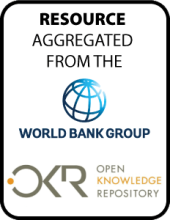/ library resources
Showing items 1 through 9 of 282.This paper reviews the performance of
the parastatal sector, with a specific focus on four main
parastatals: the Zimbabwe Electricity Supply Authority
(ZESA); the Zimbabwe Water Authority (ZINWA); the National
Land and property are usually the most important physical assets for poor households.
Malawi has pursued an agricultural-led development strategy since its independence in 1964.
This report provides technical
assistance and capacity building on the poverty measurement
methodology of the Paraguayan government. The report makes
several policy recommendations concerning urban labor market
This paper estimates the relationship
between initial village inequality and subsequent household
income growth for a large sample of households in rural
China. Using a rich longitudinal survey spanning the years
Lesotho began a structural economic
transformation in the early 1990s. The transformation has
brought higher, more secure incomes to households while the
government succeeded in dramatically improving access to
Climate change is the defining
development challenge of our time. More than a global
environmental issue, climate change is also a threat to
poverty reduction and economic growth and may unravel many
Poverty reduction on a large scale
depends on empowering those who are most motivated to move
out of poverty-poor people themselves. But if empowerment
cannot be measured, it will not be taken seriously in
These organizations have joined together to recommend the principles presented below. The document concludes with anticipated next steps, which point toward a toolkit of best practices, guidelines, governance frameworks, and possibly codes of practice by the major sets of private actors.
Pagination
Land Library Search
Through our robust search engine, you can search for any item of the over 73,000 highly curated resources in the Land Library.
If you would like to find an overview of what is possible, feel free to peruse the Search Guide.



